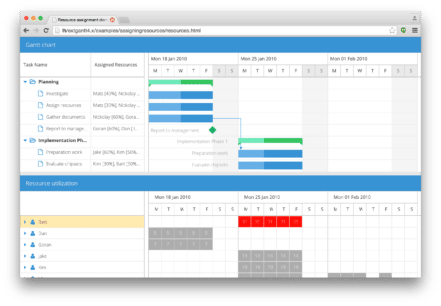Project resource scheduling is a complex part of project management.
It requires a full understanding of the work to be done, an honest assessment of how long each step will take, and informed and well planned resource planning. This is difficult; close to 20% of projects have dramatic cost and time overruns. Project managers can mitigate a lot of these issues, but there are a number of common mistakes that are a part of project resource scheduling they make that can lead to problems.
Your project may simply require the reservation of space for meetings or it may be more complex with reservations required for personnel, equipment, space, and other resources. No matter where you lie on the spectrum, it is important to have a good sense of the components of the project, the estimated timelines associated with each one, and where the risks lie. Your planning and scheduling software will help along the way, but it can’t do much to assist without good data coming in.
In this article, we look at 10 common project resource scheduling mistakes. Many of these arise from collecting incomplete information early in the project or cutting corners in the planning phase. While the planning phases may feel tedious and like they are holding the project back from starting, we will see that they are critically important to ensure that you can effectively make a plan and reserve the resources you need.
Each mistake begins with a quick scenario to illustrate it and that is followed a discussion how each mistake can affect the project and how to avoid it.
1. Insufficient Requirements Detail
Mistake Scenario
Client: “We want a completed project by next month.”
You: “Can you give us some details about exactly what you need in the project deliverable?”
Client: “You understand what we want. Just deliver that.”
Even with a clear vision of what needs to be done at the end of the project, it is extremely important to have well defined requirements and outcomes. Project managers might make this mistake because they want to get working and because enumerating specific requirements can be difficult to get from customers or from the team. This allows you to make an accurate project plan.
However, without specific requirements, it can be difficult to establish a project plan and do proper resource scheduling. Your team may set a path forward that misses a requirement that is especially important to the client. This means, at some point in the process, you will need to go back and revise your work, with the potential that a big part of the project has to be reworked after the initial deadline is met. Your schedule is shot.
To avoid this, get specific requirements lists from your customers at the start of the project. A written document with a list of exactly what should be delivered at the project conclusion will help with every part of project management.
This will also help mitigate issues that arise from changing scope in a project. A detailed, agreed upon set of requirements mean you and the client will be operating on the same set of assumptions. If the customer tries to change the scope of the project, it would necessarily mean the requirements have to change. That allows you room to discuss changes in cost and schedule instead of being on the defensive about misunderstanding the scope at the outset.
Gain business continuity and boost bottom-line results with a 360-project view. Read eBook.
2. Failing to United the Team
Mistake Scenario
You: “Ok, team. Phase 1 is due by next Monday. It is important. Let’s do it.” No further information.
Along with needing a clear set of project requirements, it is important to have a clearly articulated project intent. A common mistake is that the project and its importance is not well defined and communicated to the team.
While the project manager may know the importance of the project, this has to reach the team. It is important to have a solid communication plan in place so team members know why the project is important, what the major goals are, and how it will help the company. This should be done before you begin resource scheduling in project management.
More specifically, projects should start with the full team together. A manager should let everyone know what their role is, how their contribution will be evaluated, how it fits in to the bigger project goal, and what the payoff will be at the end. Each person should understand the urgency of the project, the deadlines, and how failure will affect the project and the company. Ultimately, people on the team should feel like they are part of something important and they should be inspired to get to work. This will improve satisfaction and on time performance so your project remains on schedule.
3. Poorly Founded Time Estimates
Mistake Scenario
You: “How long will it take to finish phase 1?”
Team member: “I don’t know. Maybe 3 days.”
You: “Sounds good!”
Time management is a critical part of managing any project. Without it, it doesn’t matter what resource scheduling software you have or what plan you have for the project; the project will fail. One common mistake that arises in time management is that the time estimates are not well founded. These estimates will be used to schedule resources and set deadlines. If the estimates are not well-founded, then there is a great risk of time and cost overruns.
To avoid this problem, a manager should meet with each member of the team to understand how they came up with their time estimates. Project management software can be especially helpful in this case because it can provide insight into how the team has performed on previous projects. These true times can be used to support the time estimates for new projects.
 4. Inaccurate Time Estimates Because of Pressure
4. Inaccurate Time Estimates Because of Pressure
Mistake Scenario:
Client: “I know you said you won’t be done with this phase until Monday, but we really need it by Thursday. What do you have to do to get it to us by then?”
You (checking plan which shows this is impossible): “I really don’t think we can do that”
Client: “Just get it done.”
You: “Ok”.
Continuing with the theme of time estimates, a frequent mistake is to give inaccurate times because of pressure from clients or management. Of course everyone wants to get their projects done as quickly as possible, but underestimating time in order to offer optimistic estimates to customers will only disrupt your project resource scheduling and end in disappointment.
This mistake gets to the issue of risk management in addition to time management. If you promise a deliverable by an unrealistic date, not only will it disrupt your overall project plan but it will also damage relationships and trust with the customer.
If you are feeling a lot of pressure from customers or managers, instead of over promising, call a meeting. Since you have followed the advice from item 3, you will have strong basis for all of your time estimates. These will be supported by reports from your resource scheduling software. You can use this to make a compelling case that supports your timeframe and plans.
5. No Formal Risk Management Strategy
Mistake Scenario:
Client: “When will the project be done?”
You: “If everything goes according to plan, we will have the project complete in 3 weeks. So…3 weeks”
If an organization has a risk management strategy, they are over 50% more likely to have success than when they take an ad hoc approach. Creating a formal plan for handling risk at the beginning of a project is important.
Every project has some type of risk. It could be that there is uncertainty about the availability of certain resources, for example. Your resource management will suffer if you do not have any plans in place to manage that risk. Your time estimations should incorporate these risk estimates. Your risk management strategy should also account for other common problems like unrealistic schedules or changes in scope. This will ensure that you know where issues might arise and that is something you can, in turn, incorporate into your resource scheduling.
Good software will allow you to see the available resources, constraints on using them, and how the required resources for many parts of the project fit together. Don’t make catastrophic estimates, but build in buffers to your project to allow for changes you have to make if risks are realized.
6. Refusing to Adapt
Mistake scenario:
Project Teammate: “The equipment we had schedule for this week is down for emergency maintenance. We’re going to have to shift the deadline on this phase.”
You: “I’m tired of excuses. I don’t care what delays there are – I want this delivered on time.”
We plan for a reason, but inevitably, issues are likely to arise at some point in your project. Having flexibility is important to ensure you can deal with those challenges and still be successful.
That flexibility should be present in all parts of the project, not just scheduling. Make decisions about your methodology, team, resources, plan, and software, but allow room to adjust. It could be another scheduling methodology works better or is more compatible with parts of the project. Resource availability may shift, requiring changes to the plan. You may receive feedback from clients or team members that is somewhat critical. Listen to their suggestions and accept advice as it comes along. You may decide to stick with your original plan. However, as a project moves along, people learn new things and get ideas that may help as they better understand the project. This can improve your schedule, avoid problems down the line, and make the team members feel like they are more actively contributing.
If you refuse to adapt in the face of obvious challenges to your plan, the project will be harder for everyone to be involved in and less likely to succeed on time and on budget. Solid planning always includes room for change and new ideas.
7. Improperly Tracking Time Off
Mistake Scenario:
You: “Next week, we begin phase 2. Bob is in charge of that part of the project, so go to him for direction on Monday.”
Team Member: “Bob is leaving for a trip to Disney World this weekend with his family. He won’t be here next week.”
A key to resource scheduling in project management is knowing what resources you have access to at specific times. There are always unknowns about which resources you will have access to and what their availability is, but accounting for what is known is important. A common mistakes managers make when making a plan is improperly tracking time off. This applies mostly to people working on the project but can also be applied to machinery, computing resources, or physical spaces. Accounting for when a resource has time off is important as you move the project forward.
Your resource scheduling software can help with this. It has the ability to track time off for team members on vacation, family leave, or for known holidays. You can also use it to track the availability of other resources. This will allow you to visually see availability, keep your plan on track, and recognize when you need to make changes.
 8. Failure to Reserve Necessary Resources
8. Failure to Reserve Necessary Resources
Mistake Scenario
You: “Next week, we have two offsite coming in for a two day meeting on the current phase of the project. We will be meeting in the big conference room because it’s the only space that will fit all of us.”
Bob: “That room is taken for meetings with a big new client next week. We can’t have our meeting there.”
Knowing which resources you need at which time is a fundamental element of making a plan for a project. However, it is a separate step to reserve them. Failure to make those reservations is a resource scheduling mistake that can lead to delays and frustration.
To support this, it is important that your organization have resource scheduling tools in place. This may be part of your desktop project management software or an online resource scheduling system. These tools make it easy to reserve resources, whether they are rooms, equipment, or people, and to know when others have them reserved to avoid conflicts. It also improves flexibility on every project; because there will inevitably be changes as the project moves forward, a central system that you can rely on for accurate availability information will make it easier to quickly reserve a resource on short notice because you know no one else will come in and claim it.
9. Bad implementation estimates
Mistake Scenario
Work Estimator: “I’ve seen projects kind of like this before, so I think it will probably take 30 hours of work to get this part of the project done”
Meanwhile…
Work Implementer to her team: “There are a couple really tricky things in this project. They only gave us 30 hours, but it will take more like 40”
Having accurate estimates of how long each part of a project will take is critical for resource planning and resource scheduling. After a while, though, people may begin estimating times for part of the project they are not working on. Even with good intent and background knowledge, this can lead to poor estimates that will throw off your schedule.
To avoid this, you want to get estimates from the implementer as much as you can. They have the fullest sense of how they will execute their work and what the complexities are. It can be tempting in large projects with many implementers to defer to a person who is responsible for many estimates. This can work, but requires clear and effective communication between the estimator and the implementers. But you should absolutely avoid estimators making their recommendations based only on their past experience and expertise. That is valuable, but must be used in conjunction with input from the people who will be doing the work.
10. Undefined Dependencies
Mistake Scenario:
You: “There are three major meetings we need to have at the beginning of this project: an all-hands general kickoff meeting for everyone to meet and discuss our goals, a designers meeting, and a managers meeting.”
Your online resource scheduling system:
Monday: Manager Meeting
Tuesday: Designers Meeting
Wednesday: All Hands Meeting
A manager may recognize the dependencies that exist within a project, but it is important to define and articulate all of them. Without well-defined dependencies, schedule planning can be difficult and produce errors like the one in the scenario above. If the All Hands meeting must occur first, so everyone knows about the project and what is required, it is critical to be explicit about the dependency that the other two meetings have on the first one.
A scheduler should provide a list of all dependencies along with their resource requirements and timeline. While it may feel like a lot of effort to create that list, it is critical both for the understanding of the manager and for the software that may automate part of the planning process.
In conclusion, mistakes can arise from poor communication and improper consideration of risk that comes with any project. Without a full understanding of the time required for each part of a project and how each part connects with one another, it is easy for resource issues to arise. You can avoid most of these mistakes with clear communication, explicit descriptions of the requirements and connections within a project, and with flexibility to manage the inevitable changes that you will have to make along the way.

 4. Inaccurate Time Estimates Because of Pressure
4. Inaccurate Time Estimates Because of Pressure 8. Failure to Reserve Necessary Resources
8. Failure to Reserve Necessary Resources




